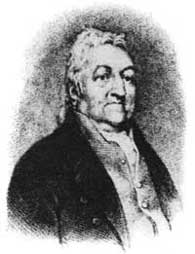<Back to Index>
- Aircraft Designer Sergey Vladimirovich Ilyushin, 1894
- Composer John Stafford Smith, 1750
- Chairman of the Council of Ministers Nikolai Alexandrovich Bulganin, 1895
PAGE SPONSOR

John Stafford Smith (30 March 1750 – 21 September 1836) was a British composer, church organist, and early musicologist. He was one of the first serious collectors of manuscripts of works by Johann Sebastian Bach.
Stafford Smith is best known for writing the music for "The Anacreontic Song", which became the tune for the American patriotic song The Star - Spangled Banner following the War of 1812, and in 1931 was adopted as the national anthem of the United States of America.
John Stafford Smith was baptised in Gloucester Cathedral, England, on 30 March 1750, the son of Martin Smith, organist of Gloucester Cathedral from 1743 - 1782. He attended the Gloucester cathedral school where he became a boy - singer. He furthered his career as a choir boy at the Chapel Royal, London, and also studied under the famous Dr. William Boyce.
By the 1770s he had gained a reputation as a composer and organist. He was elected as a member of the select Anacreontic Society which boasted amongst its membership such persons as Samuel Johnson, James Boswell, Sir Joshua Reynolds and Henry Purcell.
In the 1770s, Smith composed music for the society's constitutional song entitled "To Anacreon in Heaven" (The Anacreontic Song). The words were by Ralph Tomlinson (1744 – 1778) president of the society, and were inspired by the sixth century BC Greek lyric poet, Anacreon, who wrote odes on the pleasures of love and wine. It was first published by The Vocal Magazine (London, 1778). The song became popular in Britain and also America following the establishment of several Anacreontic Societies there.
Stafford Smith later became a Gentleman of the Chapel Royal in 1784, organist for the Chapel Royal in 1802 and Master of the Children in 1805. he also became lay - vicar of Westminster Abbey. He was organist at the Three Choirs Festival held at Gloucester in 1790.
John Stafford Smith is considered to be the first Englishman to be a serious antiquarian and musicologist. He began by publishing his A Collection of English Song in 1779. Smith's library included the Old Hall Manuscript as well as a copy of "Ulm Gesangbuch" from 1538. He also collected works that dated back to the twelfth century including some Gregorian chants. His publication "Musica Antiqua" (1812) included musical scores of works by Jacob Obrecht, Adrian Willaert, Jacob Clemens and Cristóbal de Morales with historical notes on each piece.
He died in 1836 at the age of eighty-six, allegedly caused by a grape - pip lodged in his windpipe.
In 1814, Francis Scott Key wrote the poem "The Defence of Fort McHenry" (later re-titled, "The Star - Spangled Banner"), which came to be sung to the tune of Stafford Smith's "Anacreon". This was officially designated as the national anthem of the United States in 1931. The music of "Anacreon" was also temporarily employed for the national anthem of Luxembourg until the anthem's replacement by Ons Heemecht in 1895.